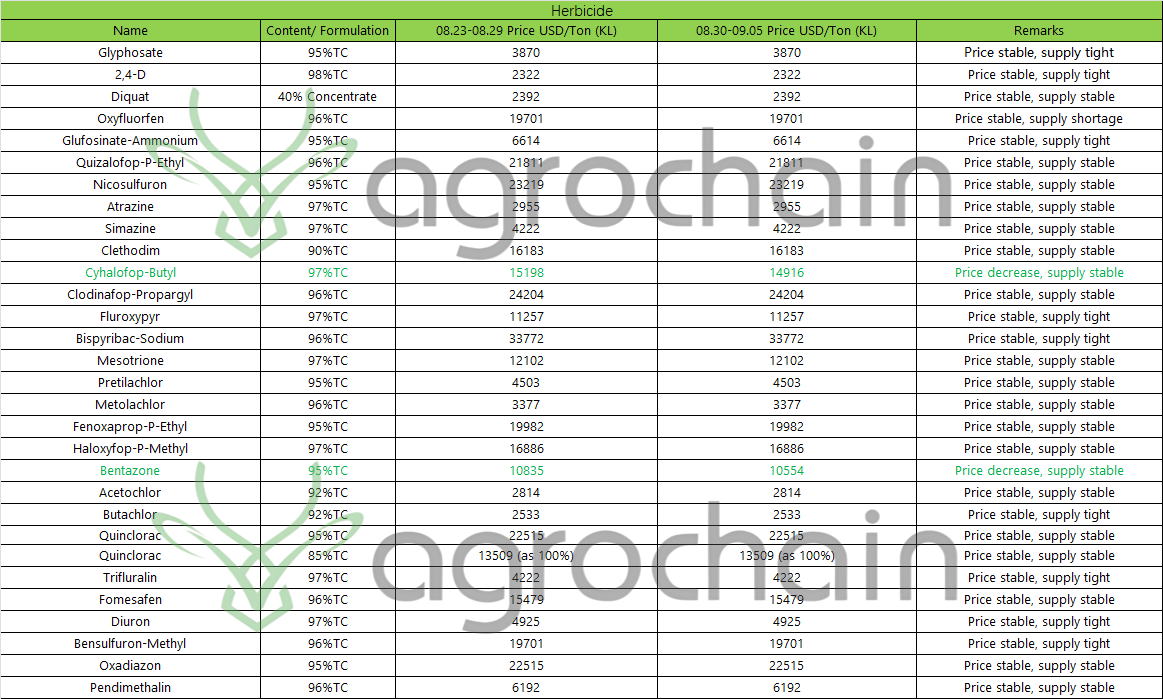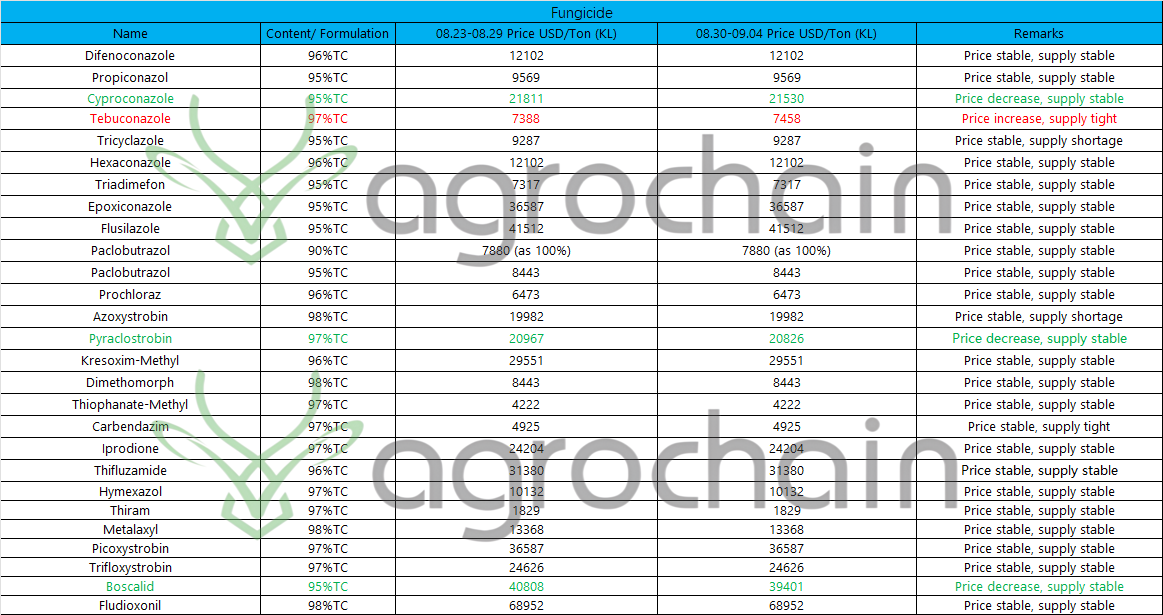China Pesticide Market Weekly Report: Price Fluctuations and Supply Dynamics (August 23 - September 5, 2023)
This report provides an in-depth analysis of price trends and supply conditions in China's pesticide market from August 23 to September 5, 2023, based on the latest market data. During this period, the market generally maintained stability, but significant price fluctuations and supply shortages were observed for some products in the insecticide, herbicide, and fungicide categories.
Insecticide Market Overview
In the insecticide sector, most product prices remained stable, and supply was sufficient. However, the following products showed notable changes:
Lambda-Cyhalothrin and Imidacloprid: These two widely used insecticides maintained stable prices and relatively sufficient supply during the reporting period.
Acetamiprid: Prices also remained stable with steady supply.
Bifenthrin: Both price and supply conditions remained stable.
Acephate: This is a noteworthy variety, with its price decreasing and supply being abundant. This could indicate intensified market competition or lower raw material costs.
Chlorantraniliprole: Similar to Acephate, Chlorantraniliprole also showed a downward price trend with ample supply.
Pyridaben and Fipronil: These two products showed signs of stable prices but tight supply, which could lead to future price increases or increased procurement difficulties.
Overall, the insecticide market showed adjustments in some varieties amidst general stability, particularly the price drops in certain products, offering potential cost-saving opportunities for buyers.

Herbicide Market Overview
The herbicide market also remained generally stable, but several key products exhibited fluctuations:
Glyphosate and 2,4-D: These two major herbicides maintained stable prices and sufficient supply, demonstrating their solid market position.
Diquat: Prices were stable, and supply was abundant.
Cyhalofop-Butyl: Its price decreased, and supply was sufficient.
Bentazone: Similar to Cyhalofop-Butyl, Bentazone's price also decreased, and supply was abundant. The price drops in these two products are worth noting.
Glufosinate-Ammonium and Nicosulfuron: These products had stable prices but tight supply, indicating strong market demand or production limitations.
Oxyfluorfen: Prices were stable but showed supply shortages, possibly due to production issues or sudden increases in demand.
In the herbicide market, some products with decreasing prices may bring benefits to agricultural production, but attention should also be paid to products with tight supply and shortages, adjusting procurement strategies in a timely manner.

Fungicide Market Overview
The fungicide market presented a more complex situation during this reporting period, with price fluctuations and supply shortages coexisting:
Difenoconazole and Propiconazole: These two commonly used fungicides maintained stable prices and sufficient supply.
Cyproconazole: Prices decreased, but supply was abundant.
Tebuconazole: This is a striking change, as Tebuconazole's price increased, and supply became tight. This could indicate strong market demand or rising production costs.
Pyraclostrobin: Its price decreased, and supply was abundant.
Boscalid: Prices also decreased, and supply was abundant.
Azoxystrobin: Prices were stable but showed supply shortages, which requires attention from buyers.
Carbendazim and Iprodione: These two products had stable prices but tight supply.
In the fungicide market, the price increase and tight supply of Tebuconazole may impact the cultivation costs of related agricultural products. Meanwhile, the price drops in Pyraclostrobin and Boscalid offer more choices for users.

Summary and Outlook
In the Chinese pesticide market from late August to early September, overall prices tended to be stable, but significant localized fluctuations still existed across categories. Acephate and Chlorantraniliprole in insecticides, Cyhalofop-Butyl and Bentazone in herbicides, and Cyproconazole, Pyraclostrobin, and Boscalid in fungicides all experienced price decreases, which is a positive signal for pesticide buyers. However, the price increase and tight supply of Tebuconazole, as well as tight supply or shortages of several varieties (such as Fipronil, Nicosulfuron, Glufosinate-Ammonium, Azoxystrobin, Carbendazim, and Iprodione), prompt market participants to closely monitor supply-side changes and plan procurement in advance to mitigate potential market risks.
Looking ahead, global agricultural product price fluctuations, raw material costs, environmental policies, and international trade relations will continue to influence the direction of China's pesticide market. It is recommended that market participants continuously monitor market dynamics and flexibly adjust procurement and sales strategies to adapt to the ever-changing market environment.


